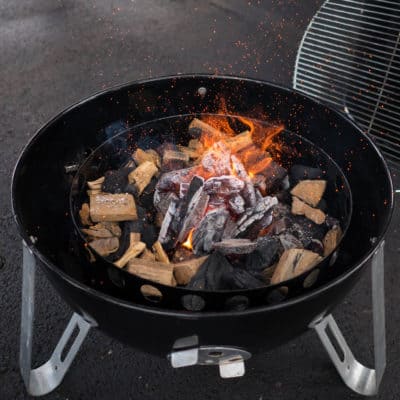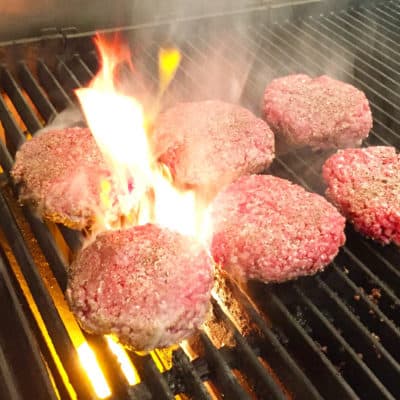Would you like to save this recipe?
Certified Angus Beef invited me to their headquarters in Wooster, Ohio 1 for #GrillTalk - two days of intensive classes about beef. Beef lessons? Of course I want to go!
(FTC disclosure: Certified Angus Beef paid for the trip, my food, and lodging while I was there. Don't tell them, but I would have happily paid to take these classes. Shh...)

Certified Angus Beef has a culinary education center, used to teach food professionals like butchers and chefs. This time it was for people like me - food bloggers. (That's why there's a hashtag in the class name. They know the audience.) When I say “people like me”, I mean “grill crazy like me”. My fellow attendees were Chris (NibbleMeThis.com), Clint (Grillocracy.com), Kita (GirlCarnivore.com), Erin (DinnersDishesAndDesserts.com), and Scott (GrillinFools.com). 2

It was an information packed couple of days. They’re proud of their beef at Certified Angus Beef, and rightly so - they care about their work, and it shows. My brain is overflowing with beef facts, and I want to dump them all on you - but I’m going to dial it back and only give you the highlights. 3

My first question was: why Wooster, Ohio? Back in the 1970’s, an Ohio rancher was disappointed by a steak dinner at a local restaurant. “I can do better than this”, he thought, and started down the road to Certified Angus Beef. What is Certified Angus Beef? It is beef from black Angus cattle, at least USDA choice grade, that meets additional quality standards for marbling, flavor, tenderness, consistency, and appearance. Phil Bass, Ph.D., corporate meat scientist for Certified Angus Beef, walked us through checking a side of Ohio prime beef. 4 He showed us the ten quality standards needed to qualify as Certified Angus Beef - and said that only 25% of Angus cattle pass this standard.

Our primary teachers were Dr. Bass and Chef Michael Ollier, corporate chef for Certified Angus Beef. This was a hands-on class; we put on cut resistant gloves, picked up butcher knives, and started cutting as they taught us how to break down different beef primals. (Note that “cut” is a relative term - most of the time we pulled the muscles apart along their natural seams, only using the boning knife5 to cut through connective tissue.)

We sectioned a chuck shoulder clod to find the flat iron steak. We broke down a top sirloin into steaks, and I found my favorite Brazilian barbecue cut - picanha. The most dangerous thing I learned? How to cut the spinalis away from the ribeye. The spinalis is the ribeye cap - the curve of muscle that wraps around the “eye” of the ribeye. I save that part of a ribeye for last, so I can savor it. Now I know how to cut it away from the ribeye and serve it as its own steak. Oh, my. “Hey, kids! Here’s the eye of ribeye, just for you. This piece? Oh, don’t worry about it - that’s the ribeye cap. I’ll make sure you don’t have to eat it.”

We also learned about custom hamburger blends…by making our own. Chris and I were a team (we were team “Liberated Tri-Tips”), and thought we had a winning combination with our blend of 30% beef short ribs, 20% ribeye trimmings, and 50% sirloin. And, at a 21% fat content, I was sure we'd have the juiciest burger. But...no. It wasn’t as beefy tasting as the winning blend of 67% chuck and 33% short rib from Clint and Kita (“Team 3” - no fancy naming here). They had a little less fat in their blend, 18%, but it was every bit as juicy as our burger, and the chuck flavor was better in a burger than our sirloin. Compared to their burger, ours was kind of bland. 6

I use “opportunity” wood. What do you have nearby? In Ohio we are near apple orchards like Bauman orchards, so I use a lot of apple wood. In Texas they have post oak - that’s why they use it. - Chef Michael Ollier

While Chef Ollier and Dr. Bass taught us, Chef Ashley Pado and Chef Peter Rosenberg fed us. They kept bringing us fantastic samples: smoked and seared tri-tip, leftover brisket bites, deep fried and tossed in wing sauce, and my favorite, substituting sirloin flap steak for skirt or flank steak in fajitas. We tasted beef charcuterie, homemade beef jerky, and barbecued beef bottom round and sirloin beef knob, to compare less expensive alternatives to brisket.

Then there was a heaping helping of food science and cooking tips. Here are a few facts that stand out in my memory:
- Dr. Bass talked about how dry aged beef has different flavors in different places. Each place has its own unique mix of molds that will grow on the beef, giving a dry aged steak from Ohio a different flavor from a dry aged steak from New York City. 7
- Chef Ollier explained why brisket should be cooked low and slow - low heat gently breaks down the collagen sheathing the muscle fibers; higher heat would squeeze the collagen, which would squeeze liquid out of the brisket. Low heat keeps the juices in the beef, where it belongs.
- Dr. Bass later explained why brisket tastes so beefy - it has a high concentration of oleic acid, a monosaturated fatty acid that our taste buds love.
- Chef Ollier showed how to form a gorgeous hamburger patty, making sure not to overwork the meat and make it tough, but working the outside just enough to form a solid outer edge so the burger doesn’t break apart as it cooks. Then he took a blowtorch to it - see the picture above. 8

“In the meat community, it is our responsibility to use all of the animal.” - Phil Bass
But the most impressive thing about the class? The people.

First were the employees of Certified Angus Beef. They care about their work, and it shows. I chatted with them as we worked through the classes, and at meals we got to sit down and talk. One dinner I was across from Jennifer Kiko, Certified Angus Beef’s blogger at GoRare.com, and another I was next to Chef Ollier. They are passionate about what they do and how they do it, and just good people - I enjoyed the chance to relax over a good meal and have conversations with them.

Then there were my fellow food bloggers. We’re unique, us food bloggers - smartphones in one hand, butcher’s knife in the other. 9 Blogging is normally a solitary experience, with communities formed through Twitter; it was great to meet in real life. I rarely get to talk shop about food blogging itself - cameras and technology, ad networks, software we’re using10, conferences to go to - it was a lot of fun to talk with people who share my passion for online food writing. Craig and Clint swapped one liners, Kita and Erin shared stories about their travels to Southeast Asia, and Chris and I were partners for the butchering. I’m sure the seam between the muscles is in there somewhere, if we can just find it…

I’m a committed carnivore. Meeting the people at Certified Angus Beef made me feel better about that; they care about the quality and welfare of the cattle they are serving us. Thank you to Certified Angus Beef for the visit; it was a fantastic couple of days of learning, and I would do it again in a heartbeat. 11
What do you think?
Questions? Other ideas? Leave them in the comments section below.
Enjoyed this post? Want to help out DadCooksDinner? Subscribe to DadCooksDinner via eMail or RSS reader, recommend DadCooksDinner to your friends, and buy something from Amazon.com through the links on this site. Thank you.







Matt Heinz says
Man I am so jealous. And I agree with you, I would have paid generously to be part of that as well!
Pam says
Are you going to have any future recipes on either the deep-fried tri tip or the homemade beef jerky? I just tasted a sirloin jerky, prepared by the people that run Spice of Life farm/kitchen, and I think I could forego all other food and live on that alone.
Mike V says
Ha! Let me see what I can do - they didn't give us recipes for them, but I can ask for details.
Mary says
The whole weekend looked fantastic and I loved all of your notes too. The entire staff at CAB is fantastic, aren't they?
Mike V says
Yes, they are great!
kita says
Totally love your use of notes 😀
Mike V says
Yeah, I was note happy with this post...